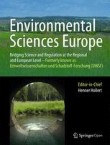Citation Impact 2023
Journal Impact Factor: 6.0
5-year Journal Impact Factor: 6.5
Source Normalized Impact per Paper (SNIP): 1.691
SCImago Journal Rank (SJR): 1.364
Speed 2023
Submission to first editorial decision (median days): 9
Submission to acceptance (median days): 93
Usage 2023
Downloads: 1,456,609
Altmetric mentions: 1,355
What can we learn from biodegradation of natural polymers for regulation?
Synthetic polymers are chemicals of emerging concern for the environment, which is mainly attributed to their persistence in environmental compartments. On the other hand, polymers exist in nature as well. The...



